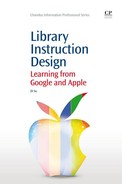0%
23Chapters
0-1Hours read
0kTotal Words
Book Description
The design philosophies of Google and Apple represent different approaches to new product design. Google's model features bottom-up and data-driven decision-making processes, while Apple's model is to design and build products top-down. Library instruction program design may learn from these differing but complementary approaches. Inspired by Google’s and Apple’s success, Library Instruction Design details how library instruction program design may learn from the philosophy of product design in the business world. In designing library instruction, a Google-philosophy approach teaches what the user wants to know while an Apple-philosophy approach teaches what the librarian thinks the user needs to learn. These two design philosophies aim at different teaching objectives reflecting library and information science education in modern society. The book is divided into five sections, with opening sections covering library instruction, the philosophy of library instruction design and design philosophy from different angles. Later sections discuss applying Google’s model and applying Apple’s model.- Offers a creative way to think about library instruction program design
- Suggests two design approaches grounded in two philosophies, represented by the design approaches of Google and Apple
- Details the differences and complementarities between top-down and bottom-up approaches to design
Table of Contents
- Cover image
- Title page
- Copyright
- Dedication
- List of tables
- Acknowledgements
- Foreword: Evolving Instructional Activities by Using the Philosophies of Google and Apple
- About the author
- Introduction
- 1. Library instruction
- 2. Philosophy and practice
- 3. Design philosophy from a different world
- 4. Learning from Google and Apple
- 5. Applying Google’s style: bottom-up
- 6. Applying Apple’s style: top-down
- 7. Conclusion
- Appendix 1
- Appendix 2
- Appendix 3
- Appendix 4
- Bibliography
- Index
